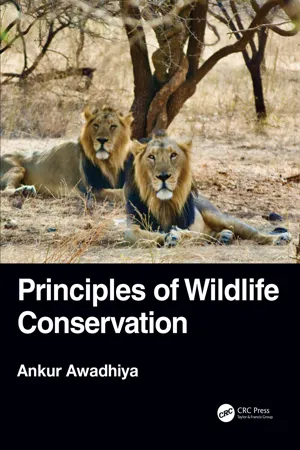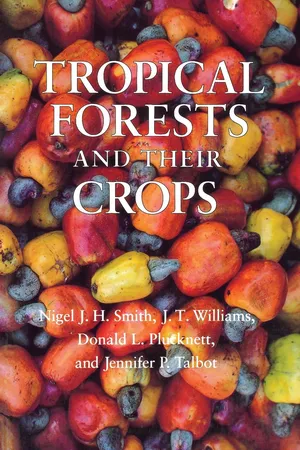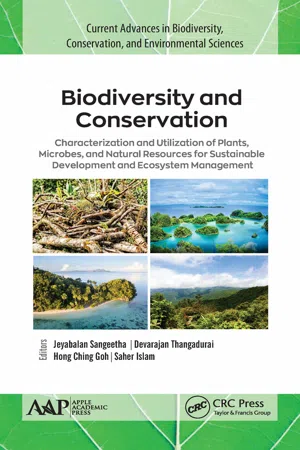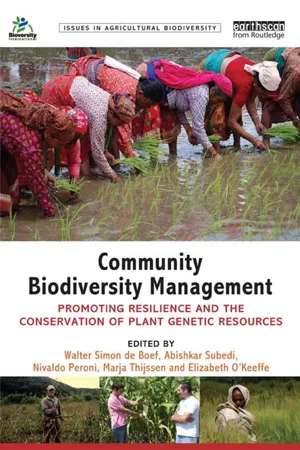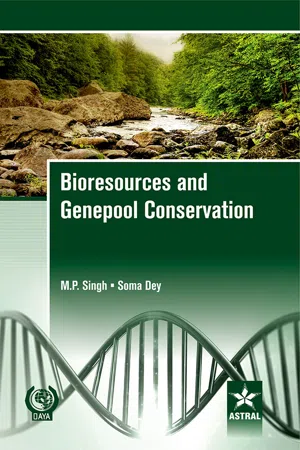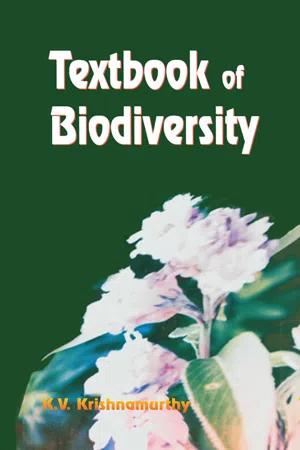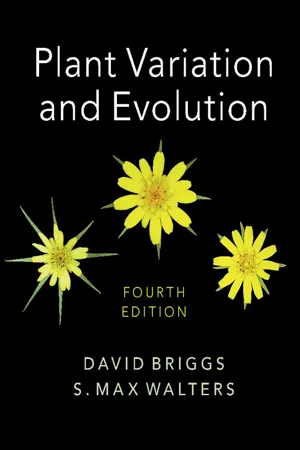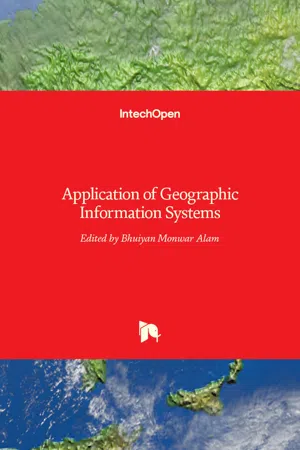Geography
In-Situ Conservation
In-situ conservation refers to the conservation of species and ecosystems in their natural habitats. It involves protecting and managing areas such as national parks, wildlife reserves, and other protected areas to safeguard biodiversity and ecological processes. This approach aims to maintain the genetic diversity of species and their natural interactions within their native environments.
Written by Perlego with AI-assistance
Related key terms
1 of 5
12 Key excerpts on "In-Situ Conservation"
- Gupta, V K(Authors)
- 2021(Publication Date)
- Daya Publishing House(Publisher)
Conservationists throughout the globe are much concerned about the threatening situations prevailing in different terrestrial and aquatic biomes, that are increasingly leading towards the change in climatic conditions as well as depletion in natural resources. Alarmed by these threats, several conservation strategies and programmes have been adopted in different countries of the world to sustain the natural resources and green environment. India, being recognized as a country of megadiversity for biological resources, has been in the process of conserving the same for decades through a variety of in situ management programmes. With a view to keep the natural ecosystems and other landscapes of natural importance unaltered, such in situ management programmes are either run by the Government or non-Government initiatives in different parts of the country. However, much of the general people and even amateurs in different sectors but related to wildlife and biodiversity conservation, are aware of such implemented programmes as well as the way they interact and act in our country. Understanding the gap in knowledge regarding the network of in situ conservation programmes and the importance of management at the landscape level in India, the author of the present text has proposed a framework under the concept of “Conservation Land”. The latter may help in better understanding of the different in situ conservation programmes running in India and also a way of integrating them towards better protection and maintenance of the different ecosystems of the country. 1. Understanding the Levels of Biodiversity The term ‘biodiversity’ is formed by a contraction of the term biological diversity . The term ‘biodiversity’ was coined by Walter G. Rosen in 1985 (UNEP, 1995), which is commonly used to describe the number, variety and variability of living organisms.- eBook - ePub
- Ankur Awadhiya(Author)
- 2021(Publication Date)
- CRC Press(Publisher)
Fig. 10.5d ].Prefer making circular reserves — they suffer less biotic pressure due to their small perimeter: area ratio [Fig. 10.5e ,g ].Connection is important: Always strive to maintain/enhance connectivity [Fig. 10.5f ] within and between reserves.Some examples of in-situ conservation areas are depicted in figure 10.6 .Figure 10.6: Examples of in-situ conservation areas.In-situ conservation offers several advantages:- Species continue to live in their natural environment — thus their natural behaviours are maintained and conserved.
- It is less disruptive and more inexpensive than ex-situ conservation.
- Protection of the natural habitat of target wildlife provides collateral protection to several species of organisms, without any extra effort.
- Most ex-situ conservation is done with the target of releasing the animals back to their natural habitat, someday. In-situ conservation sites provide suitable areas for such releases.
- Reserves double as places for scientific studies, tourism, and public awareness, besides providing employment to local communities.
- Reserves also act as places providing several economic values [Section 1.3 ] and ecosystem services — such as water purification, carbon sequestration and storage, and groundwater recharge — to the community and the nation.
However, in-situ conservation also has certain limitations:- It requires large areas that have to be earmarked for conservation — and land often has a large opportunity cost since it can also be put to multiple other uses.
- It allows only less intensive protection and management — thus the areas may be encroached upon, and animals may get poached. This is especially because it is very difficult to completely protect and manage large areas at all times.
- There is a constant threat of diseases and disasters. Being large areas, they do not permit extensive mitigation of threats, as is possible in ex-situ
- eBook - PDF
- Nigel J. H. Smith, J. T. Williams, Donald L. Plucknett, Jennifer P. Talbot(Authors)
- 2018(Publication Date)
- Cornell University Press(Publisher)
When living materials are removed from tropical forests, one of the world's most active theaters of evolution, evolutionary trajectories are deflected. IN SITU CONSERVATION The importance of in situ conservation of the genetic diversity of tropical perennial crops and their near relatives is now widely recognized. In situ conservation can provide a staging ground for the selection of tree species or genotypes for multiplication and further testing, and if warranted, du-plication in ex situ collections (Stern and Roche, 1974). But how germ-plasm can be best maintained in place raises a number of theoretical and practical issues. Several strategies can be pursued to conserve plant germ-plasm under natural conditions, but each has its limitations. Ultimately, a suite of tactics is needed that maintains crop gene pools under pristine and managed conditions and at the same time accommodates the understand-able desire of nations to develop their tropical forests. Wild populations of crops and their near relatives are found in two broad categories of in situ reserves: those designed to maintain conditions as pristine as possible and those that permit extraction or even clearing for agricultural and other purposes. National parks, biological reserves, and specialized gene parks fall into the first category, whereas national forests, Indian reserves, and extractive reserves allow for a range of economic ac-tivities such as harvesting of forest products. Another possibility is to em-ploy farmers as custodians of traditional varieties and selections in their fields and backyards. NATIONAL PARKS AND BIOLOGICAL RESERVES An impressive number of national parks have been created in countries with tropical forests within the last two decades. In some developing coun-tries, the proportion of national territory covered by parks exceeds that of 432 Tropical Forests and Their Crops many industrial countries. - eBook - ePub
Biodiversity and Conservation
Characterization and Utilization of Plants, Microbes and Natural Resources for Sustainable Development and Ecosystem Management
- Jeyabalan Sangeetha, Devarajan Thangadurai, Goh Hong Ching, Saher Islam, Jeyabalan Sangeetha, Devarajan Thangadurai, Goh Hong Ching, Saher Islam(Authors)
- 2019(Publication Date)
- Apple Academic Press(Publisher)
CBD describes that in situ conservation is the primitive conservation criteria, and suggest that ex situ methods act as a supporting factor to reach the conservation strategy. The main strategy of in situ conservation is to establish protected areas with suitable environmental conditions for the biologically diversified organisms. The main purpose is to protect the endangered species in its natural environment, either by shielding them in sanctuaries and national parks or protecting it from predators. To conserve agricultural biodiversity the unconventional farming method is used, e.g., Nilgiri biosphere reserve. 10.4.1.1 PROTECTED AREAS AND BIOSPHERE RESERVES For wild species conservation in India, National Forest Policy in 1952 planned for national parks and sanctuaries (Singh and Kushwaha, 2008). The Wildlife Act (1972) also showed potential involvement for natural biosphere conservation and preservation of biodiversity in protected areas. In India, there are about 28 tiger reserving zones launched during 1973 with an area of 37,762 km 2 (Jimmy et al., 2010) and for elephant during 1992 with 25 reserved zones of 61,200 km 2 areas considered as protected areas (Ceballos et al., 2005). Biosphere reserves are mandated approach of Wildlife Act to conserve the life forms and overall the supporting system and later permitting them to monitor or evaluate the changes occur in nature (McCool, 2006). Therefore, the core area of the biosphere reserve is a national park or wildlife sanctuaries. About 4.78% area of India is covered by PAs, i.e., 105 national parks, 531 wildlife sanctuaries, and 18 biosphere reserve areas. It is a never-ending process, and more PAs are supposed to be launched for conserving biological diversity. PAs are very small, and few are fragmented, which leads to the isolation of species populations. Hence the size needs to be optimized (Blom, 2004) - eBook - PDF
Community Biodiversity Management
Promoting resilience and the conservation of plant genetic resources
- Walter Simon de Boef, Abishkar Subedi, Nivaldo Peroni, Marja Thijssen, Elizabeth O'Keeffe, Walter Simon de Boef, Abishkar Subedi, Nivaldo Peroni, Marja Thijssen, Elizabeth O'Keeffe(Authors)
- 2013(Publication Date)
- Routledge(Publisher)
Part I Community biodiversity management and in situ conservation 1.1 General introduction Marja Thijssen, Walter Simon de Boef, Abishkar Subedi, Nivaldo Peroni and Elizabeth O’Keeffe The debate on how to implement in situ conservation The Convention on Biological Diversity (CBD) defined in situ conservation of agro- biodiversity as being the conservation of domesticated and cultivated species in the surroundings where they have developed their distinctive properties (CBD, 1992a). Defining in situ conservation of agrobiodiversity was the first step, but the major challenge over the past two decades has been its translation into conservation prac- tices that fit in the context of the livelihoods of small-scale, and often poor, farmers (Jarvis et al., 2011). How to implement in situ conservation of agrobiodiversity on- farm has been much debated. It became gradually clear that the flexible nature of farmers’ management and utilization of crops and local varieties did not match the perspective of conservationists in their design of in situ conservation on-farm (Har- don and De Boef, 1993). Part of the problem was that the various organizations involved with agrobiodiversity conservation had contrasting objectives with regards to the implementation of this conservation strategy (De Boef, 2000). Those organi- zations dedicated to the conservation of plant genetic resources (PGR) focused on supporting farming communities to continue to use local varieties. Activist non- governmental organizations (NGOs) aimed to contribute to the empowerment of farming communities to exercise their (farmers’) rights, for example, by addressing their access to and control over local PGR. Development organizations (NGOs) incorporated conservation strategies in their efforts to contribute to sustainable livelihoods. - eBook - PDF
- Singh, M P(Authors)
- 2021(Publication Date)
- Daya Publishing House(Publisher)
In this way, some of the valuable gene pools might be lost unless coordinated efforts are made towards the conservation of genetic stocks allover the world. Realizing the danger of erosion of genetic resources, the objective of providing necessary support to collection, conservation and utilisation of the plant genetic resources is concern of the world now. Diverse conservation methods are pursued according to the situation at hand. These methods can be divided broadly into ex situ and in situ . The latter cover conservation in wilderness areas, reserves, protected areas, and within traditional farming systems (so-called, on-farm conservation). Ex situ conservation involves removing the plant genetic resources from their natural habitat and placing them under artificial storage conditions. The following sections examine the different ex situ options available. Conservation of Germplasm Germplasm ( i . e ., the self-contained units of propagation in plants (seed and vegetative propagules) and reproduction in animals (embryos) is, in fact, a concentrated package of genes . It is thus obvious why biotechnological techniques are especially relevant to commercialization of unique germplasms. This includes biotechnology of hybrid and artificial seeds, germplasm banks and cryopreservation, in vitro fertilization, and embryo This ebook is exclusively for this university only. Cannot be resold/distributed. implantation. Both in situ and ex situ , the ICFRE and ICAR Institutions have put conservation methods into practice. In situ conservation is preferred option in case of grassland species because it allows for continuing adaptation of wild populations and the natural evolutionary processes. Following the man and biosphere approach advocated by the UNESCO, 14 sites have been identified as Biosphere Reserves. They have been set up in different parts of the country starting with Nilgiri biosphere reserve in 1986 covering an area of 5520 sq. - eBook - ePub
Plant Conservation
An Ecosystem Approach
- Alan Hamilton(Author)
- 2013(Publication Date)
- Routledge(Publisher)
11
Approaches to In Situ Conservation
Achieving effective conservation of plants in diverse local contexts is a major challenge for our time. This chapter outlines some approaches to in situ conservation. Complementary information is given elsewhere, such as on techniques of plant and land management (see Chapter 6 ), issues of land tenure and resource rights (see Chapter 10 ), working with communities (see Chapter 12 ) and trade in wild plants (see Chapter 14 ).THE LOCAL: THE HEART OF PLANT CONSERVATION
The local should be at the heart of plant conservation. This is where plants actually live and where people interact directly with them, and everywhere can be local. It will often be necessary in plant conservation to give attention to the details of managing plants; therefore, the physical relationships between people and plants must be a matter of primary consideration. Of course, there are actions away from the local that can be taken in favour of plant conservation - for example, the improvement of conservation information systems, the persuasion of consumers to purchase ‘green’ products or the passage of enabling laws; but 'distant’ measures will only be useful if they feed back to the local level, influencing the actual state of plants.The approaches described here are certainly not the only ways in which in situ plant conservation can be pursued. In any case, they should be applied creatively, adapted to local conditions. A combination of approaches, interacting synergistically, will likely often prove most effective in the context of projects. In situ plant conservation is a poorly developed science and practitioners have much to gain from sharing experiences and determining which approaches and methods work best in defined contexts. Approaches and methods should not be followed blindly, as if they were magic formulae; rather, each region, village and project area should be approached as a unique case (Tuxill and Nabhan, 2001). In situ - eBook - ePub
Protected Areas
A Legal Geography Approach
- Josephine Gillespie(Author)
- 2020(Publication Date)
- Palgrave Pivot(Publisher)
© The Author(s) 2020 J. Gillespie Protected Areas https://doi.org/10.1007/978-3-030-40502-1_2Begin Abstract2. Protected Areas
Josephine Gillespie1(1) School of Geosciences, University of Sydney, Sydney, NSW, AustraliaAbstract
This chapter considers the phenomenon of in situ conservation efforts through protected areas. The chapter proceeds in three parts. The first part defines protected areas and outlines the (relatively) recent history of the idea. The protected area movement is very much a phenomenon born from the nineteenth century romanticisation of landscape, most famously by luminaries such as Wordsworth, Muir and many others. Today, it is the major policy tool for environmental conservation. The second section in this chapter considers why protected areas are an essential part of the modern conservation agenda. The problem of rapidly accelerating biodiversity decline; devastating losses of habitats, ecosystems and species keeps in situ conservation at the forefront of efforts to halt or stem systemic collapse. The final part of this chapter looks at the failures of protected areas and argues that an approach informed by a different way of thinking is needed. Accordingly, we turn to consider how a legal geography lens could improve current governance and management challenges in protected areas.Keywords Protected areas In situ conservation National park IUCN Aichi Targets Legal geographyEnd Abstract2.1 Introduction
I spent a considerable part of my childhood exploring the Australian countryside and bush, none of it untouched, but all mostly at a distance from urban landscapes. It seems, thanks to the vicissitudes of memory, an idyllic scene. Many hours, it seems months and years, were spent scrambling across steep, tea-tree covered hillsides, traipsing on my pony across paddocks, jumping creeks, crashing through undergrowth and meandering through the dusty dirt roads. Of course, it was not such simple a thing, with much toil and labour and the long-forgotten frustration of rural isolation. However, one element of such a childhood continues to capture my imagination—an appreciation of the world around me. Observation, description and appreciation of the world in which we live, in whatever form it takes, holds my attention. An understanding that we are part of this scene, not removed from it, and that this scene and our involvement in it is worth documenting and protecting is a sentiment that underpins the modern protected area approach to conservation. The words of John Muir (1911 , p. 10), noted naturalist, conservation and founder of the Sierra Club, are evoked:We are now approaching the region of clouds and cool streams. Magnificent white cumuli appeared about noon above the Yosemite region … No rock landscape is more varied in sculpture, none more delicately modelled than these landscapes of the sky; domes and peaks rising swelling, white as finest marble and firmly outlined, a most impressive manifestation of world building. Every rain-cloud, however fleeting, leaves its mark, not only on trees and flowers whose pulses are quickened, and on the replenished streams and lakes, but also on the rocks are its marked engraved whether we see them or not. - eBook - PDF
- K V Krishnamurthy(Author)
- 2003(Publication Date)
- CRC Press(Publisher)
(2001) is worth mentioning, however. They assessed the anthropogenic threats to 93 protected areas in 22 tropical countries and found that the majority were not only successful in stopping land clearing and other efforts at ecosystem damage, but even showed significant recovery of natural vegetation. It is very essential to remember that great biodiversity exists even outside protected areas. This understanding forces us to realise that there is an absoluteneed to adopt a broad landscape or bioregional approach to conservation and management of biodiversity (Heywood 199%). It must also be pointed out that to date very little effort has been put into conservation efforts outside protected areas. On-farm and Home Garden Conservation On-farm Conservationinvolves the maintenance of traditional crop varieties or cropping practices and systems by farmers within traditional agricultural systems. The crop varieties maintained 'on-farm' are often known as land races. The farmers sow and harvest the crops regularly and every season keep aside a portion of the harvested seeds for resowing. This ongoing practice has safeguarded land races of several crops highly adapted to the local environment; in many instances these crops contain locally adapted alleles that have proved very useful for specific breeding programmes. - eBook - PDF
- David Briggs, S. Max Walters(Authors)
- 2016(Publication Date)
- Cambridge University Press(Publisher)
1. In their classic contribution to conservation prin- ciples and practice, Otto Frankel & Michael Soulé (1981) stress a crucial point: ‘introduction into cultivation is likely to narrow the genetic diversity of a species and to change its variation pattern in response to drastically altered selection pressures’. 2. Considering the consequences of long-term culti- vation, Professor Prance, a former Director of Kew Gardens, emphasises that ex situ conservation will ‘halt or distort the natural process of evolution’ (Prance, 2004). 3. And in a key insight regarding long-term conser- vation in gardens, Professor Peter Ashton, former Director of the Arnold Arboretum of Harvard University (Ashton, 1987), warns that ‘for all practical intents ex situ species conservation leads irreversibly to domestication’. As there are inherent limitations of ex situ approaches, we stress the overwhelming importance of in situ conservation. So far our discussion has focused largely on the conservation of species considered individually. With the aim of securing the future of all the interacting species of plants and animals in functioning ecosystems, legally protected reserve areas have been set up. How far has this aim been achieved? The role of protected areas in countering the threat of extinction Of the order of 161 000 protected areas of various sorts occupy about 10–15% of the world’s land surface (Soutullo, 2010). Historically, it is important to realise that nature reserves and national parks were first set up to protect areas of outstanding natural beauty and landscape features (Briggs, 2009). For instance, Runte (1997) makes it clear that Yellowstone National Park, the first National Park in the USA, was ‘not designed for wildlife’. As Sellars (1997) emphasises: ‘scenery has provided the primary inspiration for national parks’ and ‘tourism has been their primary justification’. - No longer available |Learn more
- (Author)
- 2014(Publication Date)
- The English Press(Publisher)
The concept is based on a new philosophy or leadership theory steering away from historical notions of power, authority, and dominance. Adaptive conservation leadership is reflective and more equitable as it applies to any member of society who can mobilize others toward meaningful change using communication techniques that are inspiring, purposeful, and collegial. Adaptive conservation leadership and mentoring programs are being implemented by conservation biologists through organizations such as the Aldo Leopold Leadership Program Approaches Conservation may be classified as either In-Situ Conservation, which is protecting an endangered species in its natural habitat, or ex-situ conservation, which occurs outside the natural habitat. In-Situ Conservation involves protecting or cleaning up the habitat itself which may include a great deal of environmental preservation, or by defending the species from predators. Ex-situ conservation may be used on some or all of the population, when In-Situ Conservation is too difficult, or impossible. Also, non-interference may be used, which is termed a preservationist method. Preservationists advocate for giving areas of nature and species a protected existence that halts interference from the humans. In this regard, conservationists differ from preservationists in the social dimension, as conservation biology engages society and seeks equitable solutions for both society and ecosystems. Some preservationists emphasize the potential of biodiversity in a world without humans Animals have not yet invaded 2/3 of Earth's habitats, and it could be that without human influence the diversity of tetrapods will continue to increase in an exponential fashion. —Sahney et al . Ethics and values Conservation biologists are interdisciplinary researchers that practice ethics in the biological and social sciences. - Bhuiyan Monwar Alam(Author)
- 2012(Publication Date)
- IntechOpen(Publisher)
Chapter 9 © 2012 Krigas et al., licensee InTech. This is an open access chapter distributed under the terms of the Creative Commons Attribution License (http://creativecommons.org/licenses/by/3.0), which permits unrestricted use, distribution, and reproduction in any medium, provided the original work is properly cited. GIS and ex situ Plant Conservation Nikos Krigas, Kimon Papadimitriou and Antonios D. Mazaris Additional information is available at the end of the chapter http://dx.doi.org/10.5772/50525 1. Introduction In the frame of the global efforts to halt the biodiversity loss by 2010 and with the aim to develop effective conservation strategies extending beyond 2010, stakeholders have recognized as a priority the in situ conservation (on site conservation) of target plant species. Still, the rapid environmental changes including climate change, habitat loss and alteration, could pose some limitations on our ability to conserve target species effectively in situ (Sharrock & Jones, 2009). As a result, conservation biologists, policy makers and managers acknowledge the importance of ex situ conservation of target plants in botanic gardens and seed banks as an essential back-up solution (Convention on Biological Diversity [CBD], 1992; Glawka et al 1994; Global Strategy for Plant Conservation [GSPC], 2002; European Strategy for Plant Conservation [ESPC], 2009; Sharrock & Jones, 2009). For the ex situ plant conservation, target species mainly refer to plant taxa (species and subspecies) presenting a narrow distribution in the wild (see Krigas & Maloupa, 2008). This category of plants usually includes: i. Local endemics (endemics of a single mountaintop e.g. Viola cephalonica (Katsouni et al., 2009) , or endemics of a single island e.g. Allium samothracicum (Krigas, 2009) , or endemics of a group of nearby areas or islands e.g.
Index pages curate the most relevant extracts from our library of academic textbooks. They’ve been created using an in-house natural language model (NLM), each adding context and meaning to key research topics.

